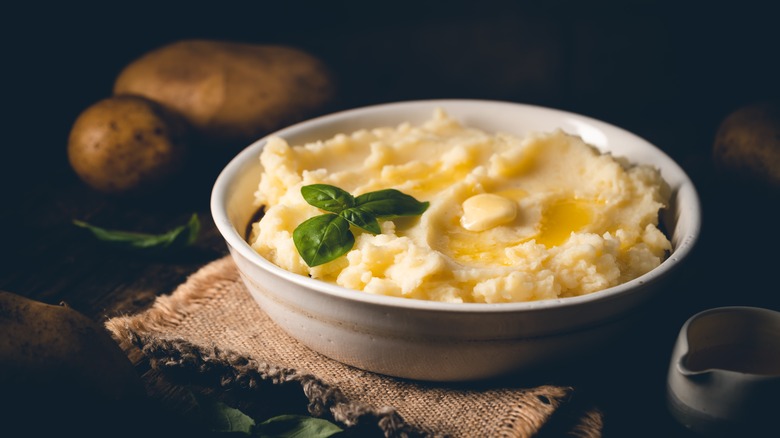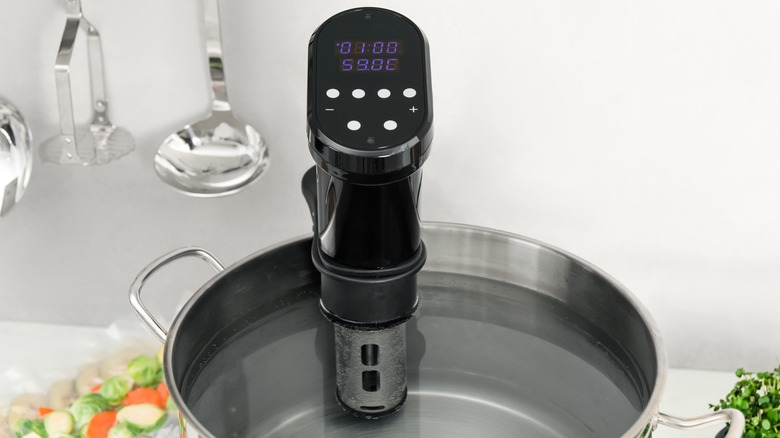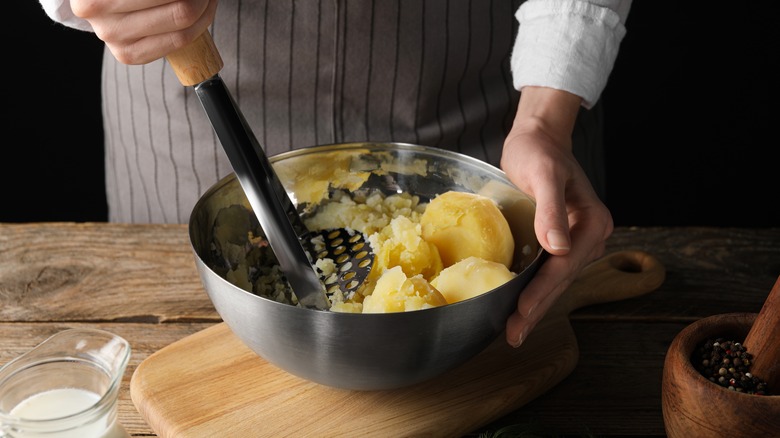Sous Vide Your Mashed Potatoes To Keep Every Flavor Intact
Mashed potatoes, simple though they may seem, are one of the biggest hit-or-miss foods. When they're done right, they are the perfect comfort food — rich, creamy, and perfect for pairing with practically any meat main. But when they are done wrong, the consequences are egregious — we're talking gummy, soupy, and worst of all, flavorless mash. These problems arise from a few critical factors in the cooking process.
The traditional method of making mashed potatoes begins with dicing and boiling them until they are tender enough to mash. However, the boiling process poses a few issues. Some of the potatoes' flavor will seep out into the water. You might think you can make up for that by adding cream and butter, but boiled potatoes present a problem there too. The potatoes will absorb a good deal of water as they cook, making them less capable of absorbing added dairy when you mash them.
The best way to avoid these pitfalls is to keep your potatoes away from water and skip the boiling stage entirely. But how then should you cook the potatoes? The answer lies in sous vide, a technique wherein the potatoes are sealed in an airtight bag and placed in a temperature-controlled pot of water to cook gradually. This makes them soft and mashable without sacrificing flavor.
What it means to sous vide food
In sous vide cooking, ingredients are placed inside a plastic bag, which is then vacuum-sealed shut. This is where the name "sous vide" comes from: French for "under vacuum". Once everything is sealed up tight, the bag is submerged in a water bath, which is temperature-controlled by a special device called a circulator. It's like a hot tub for food, maintaining a steady temperature throughout the cooking process. You set the circulator for whatever temperature a recipe calls for, and the water will never go past that point, eliminating the risk of overcooking food.
This cooking method is most commonly used for meats, like steaks or sous vide thick-cut bacon, but it is also excellent for potatoes because it avoids the two main problems with boiling. You won't lose any of the potatoes' flavor to the water, and you don't risk the potatoes becoming too waterlogged to absorb dairy.
The main obstacle with sous vide cooking is that it requires special equipment: a circulator and vacuum sealer. Sous vide machines were once found almost exclusively in restaurants, but over the past decade, many home versions have come out, typically costing around $100-200. They are simple to use, and because they eliminate the risk of overcooking, you can put a bag of potatoes in to cook and forget about them for however long it takes you to prepare the other dishes in your meal.
The basics of sous vide mashed potatoes
Breaking with the traditional method of boiling mashed potatoes may seem blasphemous, but frankly, traditional doesn't always mean best. For instance, you don't need an oven to make baked potatoes, and you sure don't need boiling water to make mash. You should set your sous vide circulator to below boiling, in the range of 195 degrees Fahrenheit, although individual recipes may vary slightly.
Before vacuum-packing the potatoes, dice them up just like you would if you were boiling them. Arrange the potatoes in a single layer so they will cook evenly. You can add cream and butter directly to the sous vide bag and other seasonings of your choosing. Your potatoes will absorb some of those rich flavors from your aromatics or seasonings in this first stage of cooking — another benefit of sous vide method.
A final perk of sous vide mashed potatoes is that you can make them in advance and use the sous vide machine to keep them warm until the rest of your dinner is ready. After cooking the potatoes, you can mash them and return them to a vacuum-sealed bag, placing them in the sous vide bath to maintain the perfect temperature for hours. If you wind up with extra, you can freeze your mashed potatoes, and you could even use your sous vide to bring them back to the right temperature before serving.


